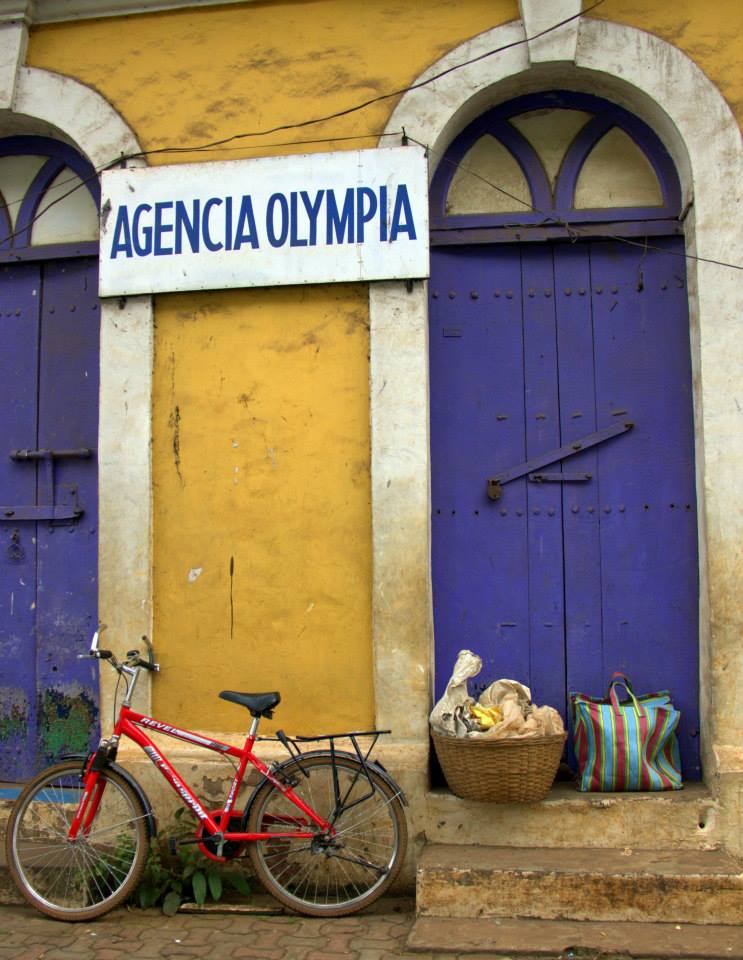My last day in north Goa was spent watching a melon coloured sunset on the broad and calm Morjim beach. It was a rain splashed evening and I was riding back to the hotel from the isolated Keri beach. I had gone visiting the fisherman’s family with whom I had stayed a couple of days and since Rama was busy, ventured alone on the long route.
North Goa beyond Anjuna gets very quaint and usually only long time expats live in those remote fishing villages. The little family welcomed me like a long lost friend and time galloped as we caught up with our lives. Soon it was late evening and sun was already lost behind a grey oppressive sky when I started my ride back. It was a beautiful drive through Goa’s huge stretches of paddy fields, coconut trees and palmyra palm groves. Small towns were the only bustling junctions and fisher folks sold glistening fresh off the boat catches by the road. I have shopped from these sellers many times and once bought a beautiful conch and a baby octopus at unbelievably low prices.
That day however, the road was deserted because of the impending storm and hardly any vehicle zipped past me. The ocean faithfully ran besides me but it was an angry turbulent one. I got caught in the storm somewhere near Morjim and frequent lightnings cracked the sky open. I am very afraid of lightning and even during my flying days, got nervous whenever my flight passed near a thunderstorm. A small road side cafe’s lights glimmered hopefully and I waited there until the storm passed. It blustered off pretty quickly and sublime sunset colours filled the sky.
The spent ocean took a luminous mother of pearl hue and the heaven burst open with the last rays of a setting sun. It looked straight out of a Renaissance painting and the quiet solitude of the beach made it divinely beautiful. Situated on the northern bank of Chapora river estuary in Pernem, Morjim is a very beautiful beach. Russians love it and it has a considerable number of Soviet expats living there. Often called “Little Russia”, Morjim in spite of its quaint charm has some very expensive and up market nightclubs.
Morjim’s biggest attraction however lies in its abundance of seasonal wildlife. The Morjim beach is a nesting and hatching habitat of Olive Ridley turtles and thankfully that saves the stretch of sand from the usual crowding of shacks. A few are allowed to operate from the road side edge of the beach and these are restricted to daylight hours only. However, sound and noise pollution have scared these gentle creatures away and nowadays hardly any turtle come to nest at Morjim. Earlier birds which used to flock to Morjim to feast on available turtle eggs are scarcely visible anymore and if not for the surreal sunset, it would have looked pretty desolate.
I left north Goa the next morning and made 3 days stopover at Panjim. Panaji/Panjim as it is known in its anglicized version is the capital of the state of Goa and one of the most colourful cities in India. Situated on the banks of Mandovi river estuary, Panjim’s colours can be credited to its Latin past. Heavy Portuguese influence can still be felt there and it is lively, vibrant and throbbing with a globally eclectic culture.
The word Panaji is derived from “panjani” (boat) and “khali (small creek) and Panjakhali had been found mentioned in 10th century copper plates of Kadamba dynasty. The Portuguese crowned it as their administrative headquarters in 1843 and renamed the city as Nova Goa (New Goa). By that time the small riverfront village had already morphed into a beautiful city with cobbled streets, red roofed skyline and colourful villas and housed the Portuguese Viceroy since 1759. Panaji’s official replacement of Old Goa as the administrative capital heralded its glorious days and the city’s charming colonial beauty is still very much tangible.
I always stay at the Bharat Lodge in Panjim and it is like my 2nd (one of my) home. Bharat Lodge has hosted me for years and I love its simple, homey atmosphere, extremely hospitable staff and its pocket friendly big, clean, old fashioned rooms. Most of their guest rooms overlook a narrow Latin Quarter lane and their 4 poster beds are sinkably soft. Bharat Lodge however belongs to stodgy owners who are staunch believers in “sadgi” (simple living) and do not subscribe to any travel portal, have any website of their own or advertise.
I bumped into them through Uttam and Sandy and have been best friends with their succession of adorable golden Labradors, all of whom were called Dolly Girl. My best Panjim memories are of eating, walking and photographing and it is 1 Indian city where I do not feel wary of being a solo woman traveler. There’s something hauntingly beautiful about Panjim’s Latin Quarter and its not just the beauty of its old houses which make it so enticing.
The streets of Fountainhas are a riot of cheery colours and they are alive with fluttering curtains, bright flower pots, peeling paints and big windows. Life echoes through the crumbling walls and every nook and cranny speaks of its Portuguese heritage. India co habits there too, in the blood of the Fountainhas residents and the Latin streets are crammed with haphazardly parked scooters, cute eyed street dogs and tangle of fruit heavy mango trees. Fisherwomen hawk their wares in the mornings and school children in uniform troop down those lanes noisily. This heady Indo Portuguese mix makes Panjim so exotically charming and its no wonder that my happiest eating and photo walking moments have been spent there. With so much of colour, spark and Mediterranean chutzpah, life is always bright in sunny Panjim.
RESPONSIBLE TRAVELING-BECAUSE I CARE.













